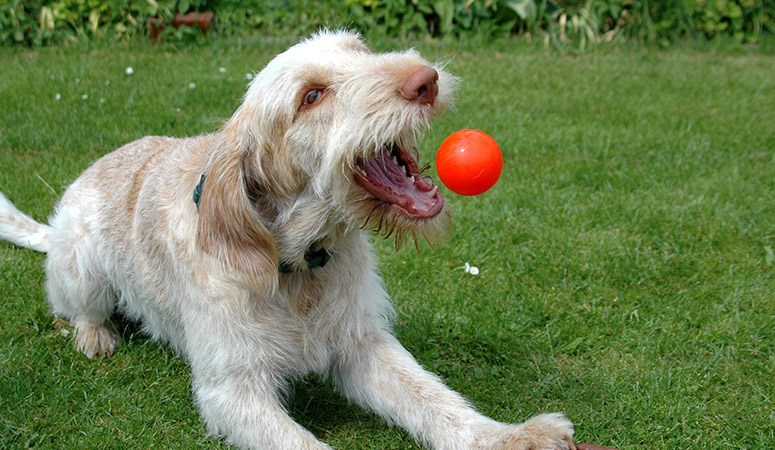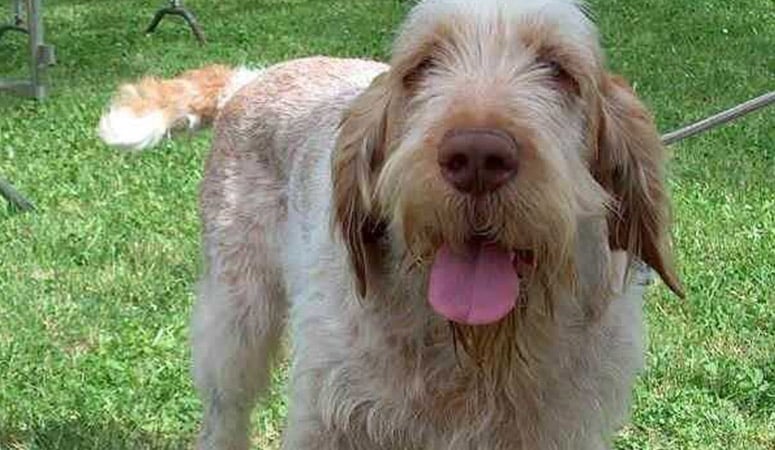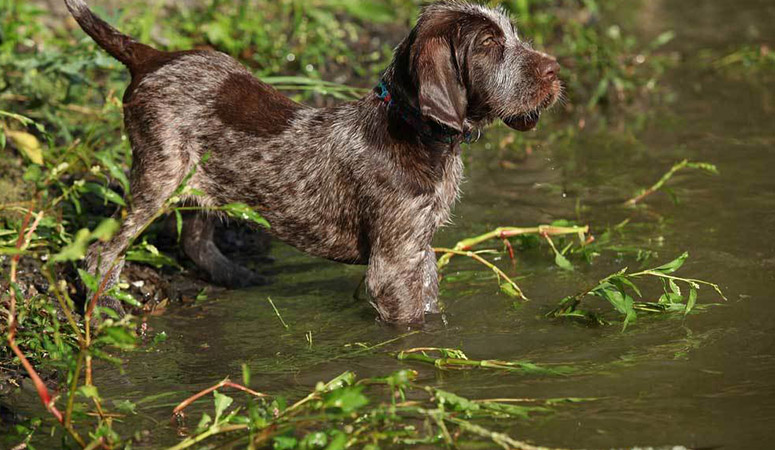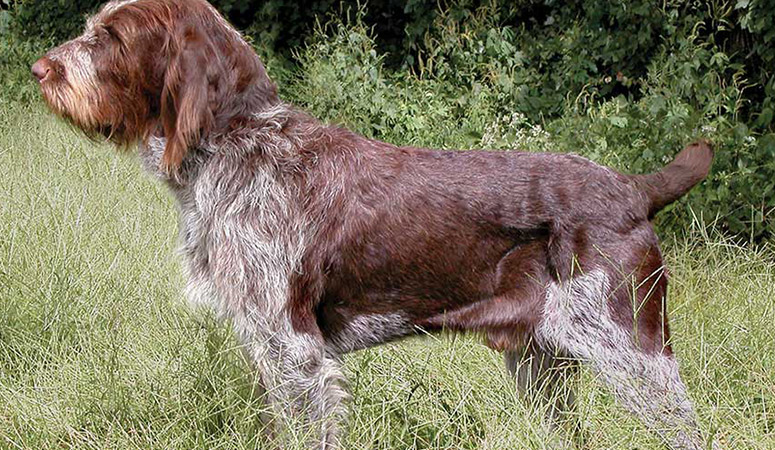Spinone Italiano
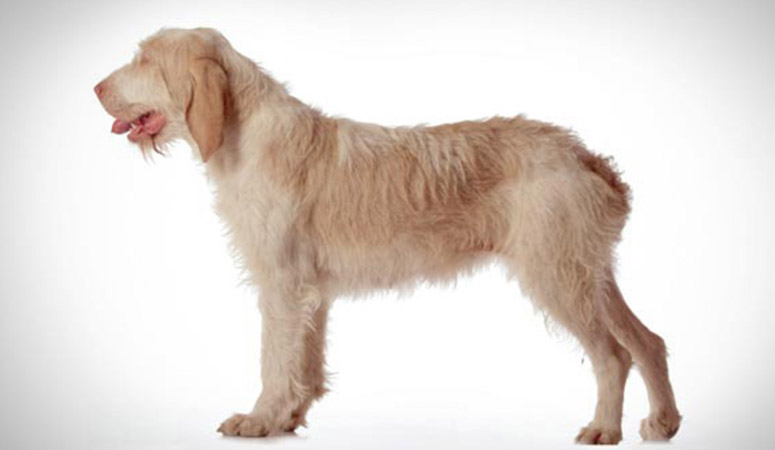
The Spinone Italiano is an Italian breed of hunting dog, traditionally used for tracking, pointing, and retrieving game. Athletic, loyal, and medium in size, Spinone Italiano is a great choice for a family who has an active lifestyle. As one of the ancient Italian lineages, the Spinone is well-known for its versatility.
| Other Names | Italian CoarseHaiRed Pointer, Italian SPinone, Italian Griffon, Italian Wire-HaiRed Pointing Dog |
| Color | Brown Roan, Orange Roan, White, White & Orange |
| Height | Males: 23-28 inches. Females: 22-25 inches. |
| Weight | Males: 70-86 pounds. Females: 62-75 pounds. |
| Life Span | 10-12 years |
| Personality | Sociable, Patient, Docile |
| Exercise | Energetic |
| Origin |
| Popularity | #116 |
| Groom Needs | Weekly |
| Kids Friendly | Yes with supervision |
| Dog Friendly | Yes with supervision |
| Watch Dog | |
| Family Dog | |
| Litter Size | 4-8 |
Spinone Italiano Pictures
Spinone Italiano Video
Introduction
The Spinone Italiano, also known as the Italian Pointer, is calmer than some of the other pointer breeds. They’re more unique too, having a scruffy look about them – but of course very charming too, with their large eyebrows and bushy beards. They stand around 27 inches at the shoulders and weigh about 90 pounds. Their coat is of medium length, and is wiry and dense, coming in three colors; brown and white, orange and white, or solid white. His coat needs to be brushed a few times each week. Look after his long beard importantly, because it can smell if it stays damp and collects bits of food in it – it needs paying attention to so that it does not get unruly and matted. When it comes to exercise, just a quick walk around the block won’t cut it for this dog; he’s going to get bored. They need plenty of time outdoors playing and frolicking and mental stimulation as well to prevent behavioral problems developing. He’s a people-orientated dog, and not suited to any household where he is left on his own – he will develop separation anxiety. After all, who doesn’t want to spend heaps of time with a dog that is playful, gentle, and a wonderful companion? He’s not the best guard dog around but he is an alert barker when a stranger comes near. They’ve got a stubborn personality so are not the best choice for new dog owners.
Living with Spinone Italiano
The Spinone Italiano has a dense, wiry coat that can help him resist weather and protect him from brush and debris. Because the Spinone has no undercoat, they should be hand-stripped, rather than scissored, to get out the dead hair, and the owner needs to remain regular brushing.
As the dog’s beard would drip water all over the place after drinking, it is suggested to keep a hand towel close by the mouth.
Also, the owner needs to check and clean your dog’s ears on a weekly basis for the signs of infection, irritation, or wax buildup. And brush the teeth several times a week to keep fresh breath and prevent gum disease. Besides, trim the dog’s nails regularly to prevent painful splitting, cracking, or a broken nail.
Spinone Italianos are highly energetic and should be exercised vigorously for at least an hour each day. Daily walks and the opportunity to run off-leash in a securely, fenced yard are great options to exercise the Spinone. And they enjoy long jogs and they are great hiking companions. While a hike or walk is always a good idea, it is not something that must be done every day. Enough exercise could keep the Spinone happy, and along with being part of the family is also important to his health as exercise, or, he may become destructive or obstinate.
Generally, it is recommended to feed a Spinone Italiano with two to three cups of high-quality dry dog food every day, divided into two meals. And there should be clean and fresh water at all times. More importantly, the food amount should depend on the dog’s weight, size, age, and activity level.
Some dogs are easy to get overweight, so you need to watch their calorie consumption and weight level all the time. Treats may be an important aid in training, but excessive intake can lead to obesity. Also, owners need to distinguish which human food is safe for dogs and which are not. If you have any problems with your dog’s weight or diet, just consult from your veterinarian.
Spinone Italianos are prone to the following health conditions: hypothyroidism, epilepsy, gastric torsion (bloat), cerebellar ataxia, eye anomalies, cataracts, hip and elbow dysplasia, allergies, etc.
Major concerns: CHD
Minor concerns: gastric torsion, ectropion, cerebellar ataxia, otitis externa
Occasionally seen: allergies, elbow dysplasia
Suggested tests:
Hip Evaluation
Elbow Evaluation
Ophthalmologist Evaluation
Total Annual Cost: $3233
Cost is estimated for the first year and may vary depending on many factors, such as dog food, health care, leash, collar, licensing, possible fencing, crates, training and obedience classes, dog-walking, grooming, treats, toys, flea, tick, and heart-worm meds, microchips, etc.
Once the owner establishes pack leadership, the Since Spinone would be not difficult to train, as they are naturally mild-mannered and submissive. And they rarely have a problem with dominance. They are smart, but a challenge, and they will shut down if training is too hard or harsh. The Spinoni can learn quickly with consistent training using positive reinforcement techniques. You can earn a well-behaved dog with interesting lessons during everyday activities.
Besides, advanced training can help give the Spinone the mental and physical stimulation it needs to be happy and well-behaved. They enjoy participating in agility training, tracking, rally, dock diving, and other dog sports with their owners.
History
The Spinone Italiano dog is believed to originate from Italy and believed to be of the oldest gun dogs ever in existence.
Officially, the breed wasn’t known as the Spinone until the start of the 19th century. Before then, they were called “Spinoso”, perhaps named after an Italian thorn bush, the spino. This bush was an ideal place for small game to hide, being impenetrable for larger animals. Only coarse-haired and thick-skinned animals could fight through the branches to retrieve game, and the Spinone proved ideal.
During World War II, the Spinone, like so many other dog breeds, nearly became extinct – the war caused this as well as the fact that the Italian hunters were using other dog breeds to hunt with. A National Club was formed to try and preserve the breed to build up their numbers again. Many breeders resorted to crossing the Spinone with other wire-haired breeds like the Wirehaired Pointing Griffon, the Boulet, and the German Wirehaired Pointer.
The Spinone was imported to North America in the 1930s, not receiving recognition from the AKC until 2000.
Did you know the plural for the Spinone Italiano is Spinoni Italiani?
Helpful Information
Breed Club: SPINONE CLUB OF AMERICA
Breed Club Link: http://www.spinoneclubofamerica.com/
Breed Club Rescue: Spinone Rescue of America
Breed Club Rescue Link: https://www.spinoneclubofamerica.com/About-Spinoni/Rescue

